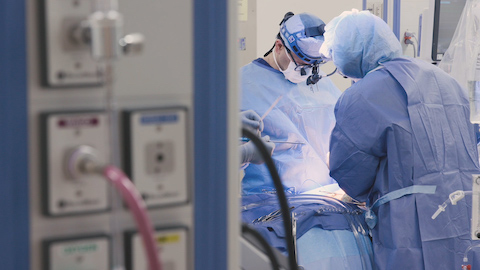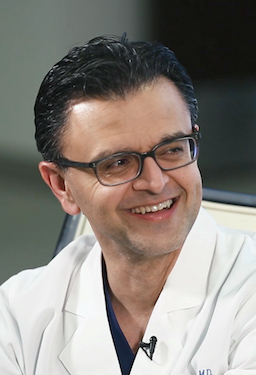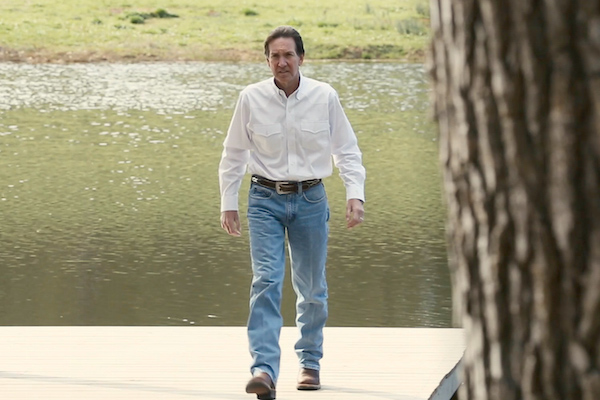A minimally traumatizing surgery for a maximum-risk heart
DALLAS – May 17, 2017 – Seven percent. That’s the percentage of the blood in Tommy Lloyd’s heart that would flow through his aorta with each squeeze of his heart. For a healthy heart, that number should be about 70 percent.
While most people have a three-part aortic valve that opens and closes to send blood from the heart to the body, Mr. Lloyd was born with a two-part valve, which tends to stiffen and wear out earlier. And that’s what happened to Mr. Lloyd.
The discovery sent him to Dr. Neelan Doolabh, Associate Professor of Cardiovascular and Thoracic Surgery at UT Southwestern, who specializes in a rare minimally invasive procedure for valve-replacement that minimizes the trauma of heart surgery. The specialized technique accounts for less than 1 percent of aortic valve replacement surgeries, but for people like Mr. Lloyd, it’s a critical option to have.
“I’m going to spell this out for you,” Dr. Doolabh told Mr. Lloyd. “We can replace the valve without problem, but your heart is so weak it’s going to be hard restarting your heart after the heart-lung machine.”
Rather than the more traditional 10-inch vertical incision down the center of the chest to access the heart, Dr. Doolabh recommended the minimally invasive approach, which requires less than a 2-inch incision between the ribs. Almost all patients needing a valve replacement are good candidates for the technique, which Dr. Doolabh has been performing for a decade, but it’s especially valuable for patients who are older, obese, or have multiple health issues.

“It was terrifying to be told that I was that ill,” Mr. Lloyd said. “But I told him I would rather flame out than fade away.”
On the day of his surgery, Mr. Lloyd said, he was “yukking it up, trying to keep things light.” But when his wife bent down to kiss him and say she’d see him later, the fear must have shown in his face. While his team was making the final preparations for the surgery, Dr. Doolabh quietly reached for Mr. Lloyd’s hand with reassurance.
Dr. Doolabh and the surgical team took just two hours to replace the damaged aortic valve, and when it came time for Mr. Lloyd’s heart to restart, it responded with a normal “beat, beat, beat.”
“I was so happy that I lived,” Mr. Lloyd recalled of awakening in his room. “The things I’d worried about – Who was going to take care of my wife? Would I see my three grandkids grow up? – it was all OK.”
Mr. Lloyd said he feels immense gratitude for Dr. Doolabh and the rest of the team. “When I was being discharged, Neelan came by and we talked. I had tears in my eyes and I apologized for the tears,” Mr. Lloyd recalled. “He said, ‘It’s quite normal. You’ve been on the biggest roller coaster ride of your life.’”

Recovery for the traditional open-heart surgery approach can be six to eight weeks before patients can return to normal activities like driving. With the minimally invasive approach, people can often resume normal activities in about 10 days and – more importantly for Mr. Lloyd’s situation – the minimally invasive surgery is far less stressful on the body.
“Instead of the traditional surgery dividing the breast bone, this less traumatic procedure makes heart surgery a viable option for patients with complex health situations,” Dr. Doolabh said.
For Mr. Lloyd, who had always led an active life on his East Texas ranch, it meant doing many of the things that he hadn’t been able to do for quite a while before the valve replacement.
“Living on acreage, there’s always something to do. Building a fence. Taking down a pine tree and cutting it up to make a bonfire. Have I cut down any 90-foot trees lately? No, but that will be happening when it needs to be done,” he said.
“My goal was to turn my heart clock back 10 years, and that goal has been accomplished.”

About UT Southwestern Medical Center
UT Southwestern, one of the premier academic medical centers in the nation, integrates pioneering biomedical research with exceptional clinical care and education. The institution’s faculty includes many distinguished members, including six who have been awarded Nobel Prizes since 1985. The faculty of almost 2,800 is responsible for groundbreaking medical advances and is committed to translating science-driven research quickly to new clinical treatments. UT Southwestern physicians provide medical care in about 80 specialties to more than 100,000 hospitalized patients and oversee approximately 2.2 million outpatient visits a year.
###
Media Contact: Cathy Frisinger
214-648-3404
cathy.frisinger@utsouthwestern.edu
To automatically receive news releases from UT Southwestern via email,
subscribe at www.utsouthwestern.edu/receivenews




